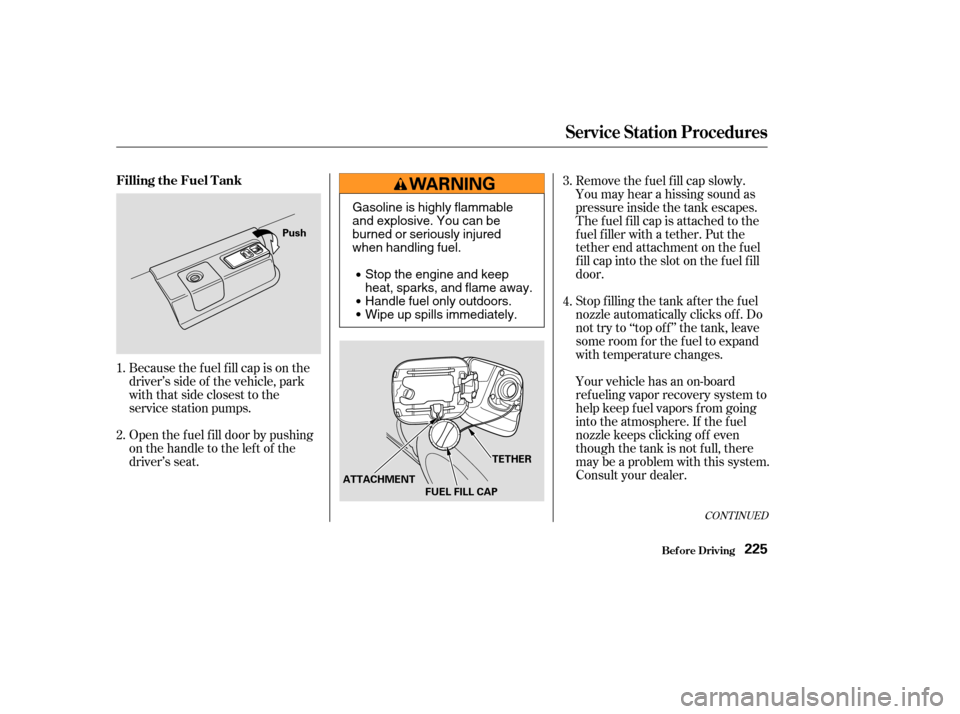Page 228 of 429

Open the f uel f ill door by pushing
onthehandletotheleftof the
driver’s seat. Because the f uel f ill cap is on the
driver’s side of the vehicle, park
with that side closest to the
service station pumps.Remove the f uel f ill cap slowly.
You may hear a hissing sound as
pressure inside the tank escapes.
The fuel fill cap is attached to the
f uel f iller with a tether. Put the
tether end attachment on the fuel
f ill cap into the slot on the f uel f ill
door.
Stop f illing the tank af ter the f uel
nozzle automatically clicks of f . Do
not try to ‘‘top of f ’’ the tank, leave
some room f or the f uel to expand
with temperature changes.
Your vehicle has an on-board
ref ueling vapor recovery system to
help keep f uel vapors f rom going
into the atmosphere. If the fuel
nozzle keeps clicking of f even
though the tank is not full, there
maybeaproblemwiththissystem.
Consult your dealer.
3.
4.
1.
2.
CONT INUED
Service Station Procedures
Bef ore Driving
Filling the Fuel Tank
225
FUEL FILL CAP TETHER
Push
ATTACHMENT
Gasoline is highly flammable
and explosive. You can be
burned or seriously injured
when handling fuel.Stop the engine and keep
heat, sparks, and flame away.
Handle fuel only outdoors.
Wipe up spills immediately.
Page 231 of 429
Check the engine oil level every time
you f ill the car with f uel. Wait a f ew
minutes af ter turning the engine of f
bef ore you check the oil.Wipe the dipstick with a clean
cloth or paper towel.
Remove the dipstick (orange
handle/loop).
1. 2.
Service Station Procedures
Bef ore Driving
Oil Check
228
4-cylinder models
6-cylinder models
DIPSTICK
(Orange Handle)
DIPSTICK
(Orange Loop)
Page 233 of 429
Refer toon page f or inf ormation
on checking other items in your
Honda.
Look at the coolant level in the
radiator reserve tank. Make sure it is
between the MAX and MIN lines. If
it is below the MIN line, see
on page f or
inf ormation on adding the proper
coolant. 299 291
Service Station Procedures
Bef ore Driving
Owner Maintenance
Checks
A dding
Engine Coolant
Engine Coolant Check
230
UPPER MARK
LOWER MARK RESERVE TANK
4-cylinder models MIN MAX MAX
RESERVE TANK
6-cylinder models MIN
6-cylinder models
Page 234 of 429

A cold engine uses more f uel than a
warm engine. It is not necessary to
‘‘warm-up’’ a cold engine by letting it
idle f or a long time. You can drive
away in about a minute, no matter
how cold it is outside. The engine
will warm up f aster, and you get
better f uel economy. To cut down on
the number of ‘‘cold starts,’’ try to
combine several short trips into one.
You can improve f uel economy by
driving moderately. Rapid acceler-
ation, abrupt cornering, and hard
braking use more f uel.
Always drive in the highest gear that
allows the engine to run and acceler-
ate smoothly.
The air conditioning puts an extra
load on the engine which makes it
usemorefuel.Turnoff theA/Cto
cut down on air conditioning use.
Use the f low-through ventilation
when the outside air temperature is
moderate.
The condition of your car and your
driving habits are the two most
important things that affect the fuel
mileage you get.
Always maintain your car according
to the maintenance schedule. This
will keep it in top operating condition.
Depending on traf f ic conditions, try
to maintain a constant speed. Every
time you slow down and speed up,
your car uses extra f uel. Use the
cruise control, when appropriate, to
increase f uel economy.
An important part of that mainte-
nance is the
(see page ). For
example, an underinf lated tire
causes more ‘‘rolling resistance,’’
which uses f uel. It also wears out
f aster, so check the tire pressure at
least monthly.
In winter, the build-up of snow on
your car’s underside adds weight and
rolling resistance. Frequent cleaning
helps your f uel mileage and reduces
thechanceof corrosion. 291 Driving Habits
Owner Maintenance
Checks Car Condition
Fuel Economy
Bef ore Driving231
Page 242 of 429

This section gives you tips on
starting the engine under various
conditions, and how to operate the
5-speed/6-speed manual and
automatic transmissions. It also
includes important inf ormation on
parking your car, the braking system,
the Traction Control System, and
f acts you need if you are planning to
tow a trailer.........................
Preparing to Drive .240
.......................
Starting the Engine .241
Starting in Cold Weather ....................
at High Altitude .242
....
5-speed Manual Transmission . 243
.....
Recommended Shif t Points . 244
..............
Engine Speed Limiter . 244
....
6-speed Manual Transmission . 245
.....
Recommended Shif t Points . 246
..............
Engine Speed Limiter . 246
.......................
Reverse Lockout .246
..............
Automatic Transmission . 248
.
Shif t Lever Position Indicator . 248
................
Shif t Lever Positions . 248
..............
Engine Speed Limiter . 251
....................
Shif t Lock Release . 251
...........................................
Parking .253
..............................
Parking Tips .253
.....................
The Braking System .254
.............
Brake Wear Indicators . 254
...............
Brake System Design . 255
.......................
Anti-lock Brakes .255
Important Saf ety .........................
Reminders .256
........................
ABS Indicator .256 ..............
Traction Control System . 258
...............
TCS ON/OFF Switch . 259
.........
TCSActivationIndicator . 259
...............
Driving in Bad Weather . 261
...........................
Towing a Trailer .263
Driving
Driving239
Page 243 of 429

Make sure all windows, mirrors,
and outside lights are clean and
unobstructed. Remove f rost, snow,
or ice.
Check that the hood and trunk are
f ully closed.Check the adjustment of the seat
(see page ).
Check the adjustment of the
inside and outside mirrors (see
page ).
Check the adjustment of the
steering wheel (see page ).
Make sure the doors are securely
closed and locked.
Fasten your seat belt. Check that
your passengers have f astened
their seat belts (see page ).Turn the ignition switch ON (II).
Check the indicator lights in the
instrument panel.
Start the engine (see page ).
Check the gauges and indicator
lights in the instrument panel (see
page ).
Check that any items you may be
carrying with you inside are stored
properly or f astened down
securely. Visually check the tires. If a tire
looks low, use a gauge to check its
pressure.
Youshoulddothefollowingchecks
and adjustments every day bef ore
you drive your car.
3.2.
1.
4. 5.
6.
7.
8.
9. 11.
12. 10.
16 61
94
108 80 241
Preparing to Drive
Driving240
Page 244 of 429

Push the clutch pedal down all the
way. START (III) does not
f unction unless the clutch pedal is
depressed. Apply the parking brake.
In cold weather, turn of f all
electrical accessories to reduce
the drain on the battery.
Make sure the shif t lever is in
Park. Press on the brake pedal.If the engine still does not start,
press the accelerator pedal all the
way down and hold it there while
starting in order to clear f looding.
As bef ore, keep the ignition key in
the START (III) position f or no
more than 15 seconds. Return to
step 5 if the engine does not start.
If it starts, lif t your f oot of f the
accelerator pedal so the engine
does not race.
Without touching the accelerator
pedal, turn the ignition key to the
START (III) position. If the engine
does not start right away, do not
hold the key in START (III) f or
more than 15 seconds at a time.
Pause f or at least 10 seconds
bef ore trying again.
If the engine does not start within
15 seconds, or starts but stalls
right away, repeat step 4 with the
accelerator pedal pressed half-way
down. If the engine starts, release
pressure on the accelerator pedal
so the engine does not race.
1.
2.
3.
4.
5.6.
Automatic Transmission:
Manual Transmission:
Starting the Engine
Driving241
Page 245 of 429
Use the f ollowing procedure:Turn of f all electrical accessories
to reduce the drain on the battery.
Push the accelerator pedal half-
way to the f loor and hold it there
while starting the engine. Do not
hold the ignition key in START
(III) f or more than 15 seconds.
When the engine starts, release
the accelerator pedal gradually as
the engine speeds up and smooths
out.
An engine is harder to start in cold
weather. The thinner air f ound at
high altitude above 8,000 f eet
(2,400 meters) adds to the problem.
If the engine fails to start in step 2,
push the accelerator pedal to the
f loor and hold it there while you
try to start the engine for no more
than 15 seconds. If the engine
does not start, return to step 2.
1.
2.
3.
Driving
Starting in Cold Weather at High
A ltitude (A bove 8,000 f eet/
2,400 meters)
Starting the Engine
242